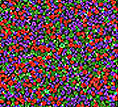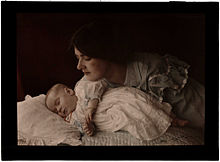Autochrome process
The autochrome process is an early process for producing colored photographs in the form of a slide . It was developed in 1903 by the brothers Auguste and Louis Lumière in Lyon. With the process based on color screening it was possible for the first time to generate a color image with a single image. The prerequisite for the very realistic color reproduction by the Autochromes was the previous development of panchromatic emulsions , i.e. light-sensitive substances that reproduce all colors of the color spectrum evenly. However, the exposure time for one shot was very long.
Technical procedure
Autochrome plates were sold for the first time in 1907 and worked according to the so-called grain grid method.
To produce the autochrome plates using the Lumière brothers' method, an extremely thin layer of orange-red, green and violet-colored potato starch granules with a diameter of around 15 µm to 20 µm was applied to a glass plate coated with adhesive using a badger hair brush. The granules were mixed so that none of the three colors emerged and were applied so that the layer was only one grain thick. In order to prevent the passage of white light, the spaces that occurred due to the oval grain shape were filled with pulverized charcoal.
The starch granule layer was covered with a varnish with a lower refractive index and then a panchromatic silver bromide gelatin emulsion was applied as a light-sensitive layer .
The exposure of the plate in the camera took place from the uncoated side of the glass plate, i.e. through the colored starch granules. The silver bromide crystals behind a violet starch grain received only violet light. During the subsequent development they only blackened in proportion to the violet component of the light in the relevant area. The same applies to the crystals behind orange-red or green starch granules.
The exposed plate was developed in a conventional black and white process. If you then looked at them in white light, you saw a color negative: where the original had a high proportion of violet, the silver bromide crystals behind the violet starch granules had become very black. The purple starch granules that were still in place meant that hardly any light could penetrate. The same applies to the other two colors.
In order to obtain a color-correct image, the autochrome plate had to be copied onto another autochrome plate. That means, with the help of the color negative, another autochrome plate was exposed and developed again. By reversing it twice, a color-correct positive was created .
In all cases, the color impression in the eye resulted from the additive color mixing of the adjacent differently colored pixels, as with color screens or pointillist paintings .
Instead of copying, reverse development was also possible, which delivered a slide in one operation.
In the case of the autochrome material from Agfa (" AGFA color plate "), which was brought onto the market later (1916), the color raster used was not potato starch granules, but the finest color droplets. Since the droplets collided directly with one another, the AGFA process had the advantage that no gaps between the color particles had to be masked with carbon dust. The AGFA color plate therefore looked a little lighter and more transparent than the autochrome plate by the Lumière brothers. In the case of the so-called “ New AGFA color plate ” published in 1923 , the sensitivity could be increased; due to a thinner layer of color droplets, the images recorded with it appeared more brilliant and at the same time improved color reproduction.
Distribution and inferior competitive processes
The Lumière brothers presented the autochrome process to the public on June 10, 1907 in the Photo Club de Paris . At this time Alfred Stieglitz and Edward Steichen were in Paris, the latter was present at the presentation. Steichen, Stieglitz, Frank Eugene and Heinrich Kühn tested the new process intensively in the summer of 1907 during a stay in Tutzing, Bavaria. After returning to the USA, Stieglitz presented the first results to the public in his gallery in September 1907. But other recognized photographers such as Nicola Perscheid or Emma Barton soon made intensive use of the new opportunities. As early as 1908, the first autochromes were reproduced using color prints, although the printing technology cannot match the optical impression of the projected autochrome slide. Individual positive paper copies could be made with utopaper, askan printing or, after the production of one-color partial negatives, also three-color bromo-oil printing.
In the 1930s, autochromic slides were widespread, and even before the First World War , stereoscopic autochromes with plastic, i.e. three-dimensional reproduction in natural colors enjoyed great popularity with special portable wooden frames .
Even before the beginning of the 1920s, a method, albeit extremely seldom used, was discovered to record moving images on flexible autochrome film, although the colored moving images before 1932, if they worked with natural colors and were not re-colored by hand, were mainly based on the qualitatively inferior ones Kinemacolor (from 1908) and the predecessor of the same name (from 1917) of the later Kodachrome , which uses only two colors, but is cheaper and technically simpler .
Dissemination and succession
Although the Lumière brothers were already producing over 6,000 autochrome plates a day in 1913, the process ultimately failed to establish itself in the long term and not in the broad masses. The production costs and thus also the purchase price were high, and the autochrome plates required an exposure time of sixty to eighty times longer than the black and white dry plate material used at the time (this initially had a maximum of 3 ASA according to the newer standard (from 1960), later a maximum of 6 ASA (Agfa special plate, from 1914)).
It was therefore quickly replaced by the three-color Agfacolor (from 1932), in the photo and amateur film sector from the three-color Kodachrome introduced in 1936, whose initial light sensitivity was 20 ASA , in the cinema from the two-color film Cinecolor (from 1932, further developed for three colors in 1948) for cheaper productions and the three-color Technicolor (mainly in the USA, also from 1932) or Agfacolor (Germany, from around 1940), which finally became established in professional cinema .
Around 20 million autochrome photographs were taken between 1907 and the mid-1930s.
See also
literature
- Arthur von Hübl : The theory and practice of color photography with autochrome plates (= Encyclopedia of Photography. Issue 60). 2nd, revised edition. Knapp, Halle (Saale) 1909.
- Nathalie Boulouch: Les autochromes Lumière, la couleur inventée. Photographies couleur, collection privée de la famille Lumière, Lyon 1903. ScheiBli Editions, Lyon 1999, ISBN 2-911467-00-0 . (French English)
- Alan Buckingham: Photography. From the camera obscura to the digital camera. Gerstenberg, Hildesheim 2005, ISBN 3-8067-5515-9 .
- Caroline Fuchs: The Autochrome in Great Britain: Revolution in Color Photography. Studies in Theory and History of Photography, Vol. 9. De Gruyter, Berlin 2017, ISBN 978-3-11-048588-2 . (German)
Individual evidence
- ↑ fusion Lumiere et Jougla. Merger agreement of the companies A. Lumière et ses fils and Plaques, pellicules et papiers photographiques J. Jougla dated March 10, 1911, accessed from the autochromes.culture website on November 6, 2011. (PDF)
- ^ Walter Koschatzky: The art of photography. Technology, history, masterpieces . dtv, Munich 1987, ISBN 3-7010-0386-6 , p. 187.
- ^ Wilfried Baatz: History of Photography . Dumont, Cologne 1997, ISBN 3-7701-3616-0 , p. 69.
- ↑ Wolfgang Baier: Source representations for the history of photography. 2nd Edition. Schirmer / Mosel, Munich 1980, ISBN 3-921375-60-6 , p. 382 f. with the reproduction of a font by the Lumière brothers
- ↑ a b Wolfgang Baier: Source descriptions for the history of photography. 2nd Edition. Schirmer / Mosel, Munich 1980, ISBN 3-921375-60-6 , p. 384.
- ↑ a b c Walter Koschatzky: The art of photography. Technology, history, masterpieces . dtv, Munich 1987, ISBN 3-7010-0386-6 , p. 188.
- ^ The American Photography Museum website , accessed December 31, 2011.
- ↑ Michel Frizot in: Michel Frizot (Ed.): A New History Of Photography . Könemann, Cologne 1994/1998, ISBN 3-8290-1328-0 , p. 423.
- ↑ Wolfgang Baier: Source representations for the history of photography. 2nd Edition. Schirmer / Mosel, Munich 1980, ISBN 3-921375-60-6 , p. 383.
- ↑ Aaron Scharf: Uit de geschiedenis van de photography. Focus, Amsterdam / Brussel, 1980, ISBN 90-10-03586-7 , p. 154 ff.
- ^ Peter Tausk: The history of photography in the 20th century. 2nd Edition. Dumont, Cologne 1980, ISBN 3-7701-0813-2 , p. 106.
- ^ Peter Tausk: The history of photography in the 20th century. 2nd Edition. Dumont, Cologne 1980, ISBN 3-7701-0813-2 , p. 14.
- ^ Walter Koschatzky: The art of photography. Technology, history, masterpieces . dtv, Munich 1987, ISBN 3-7010-0386-6 , p. 189.
Web links
- Autochromes Lumières website (in French)
- Website on the Autochromes Lumières ( Memento of January 28, 2011 on the Internet Archive ) (in French, English and Spanish)
- German Society for Photography: 100 Years of Autochrome



